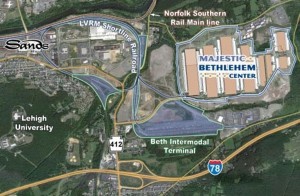I’m outspoken in my criticism of the township supporting warehouse development.
My reasons are many. This type of development represents more unsustainable growth for our suburban township. It affects our quality of life (tractor trailer traffic on local residential roads not designed to handle it), and it’s the least environmentally friendly development possible considering paving over of regionally significant farmland.
I’ve been asked before a very valid question. If not here then where? Came across an article today that shows in practice what has been my reponse. We have significant brownfields locally. The old Mack Truck plant in Allentown and remaining Steel property in Bethlehem are examples.This is where distribution centers and warehouses belong. What’s best for the region? Not what puts the most money in certain developers pockets.
A great example of Brownfield redevelopment locally, the planned Majestic distribution hub located near the Hellertown exit of Rt. 78 is an excellent example of where this type of development should be encouraged. This is a great project for not only Bethlehem but the entire region.
Description:
Majestic Distribution Hub – 800,000 foot facility on undeveloped former Bethlehem Steel property. This area has existing infrastructure already well on the way to being able to handle increased truck traffic.
Some of the major benefits of building on this existing brownfield:
- Adaptive reuse of a former industrial facility from a previous era. Great example of smart growth principle in practice.
- The ideal location next to the intermodel cuts down on drayage.
- Direct access to I-78.
- The building will have LEED & US-EPA Smartway Transport Design certification.
- Direct accessibility and access to labor. This is where jobs are needed!
- According to the NJ Institute of Technology, executives interviewed note increasing difficulties in recruiting and retaining workforces for facilities. Brownfield sites provide better access to labor markets because of location. Brownfield sites tend to be located in more developed, urbanized locations, with greater access to the region’s transit system and labor pools

